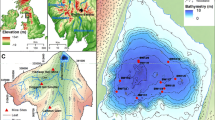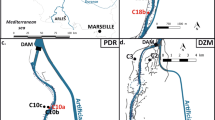Abstract
The historic processing of precious metal ores mined from the Comstock Lode of west-central Nevada resulted in the release of substantial, but unquantified amounts of mercury-contaminated mill tailings to the Carson River basin. Geomorphic and stratigraphic studies indicate that the introduction of these waste materials led to a period of valley-floor aggradation that was accompanied by lateral channel instability. The combined result of these geomorphic responses was the storage of large volumes of mercury-enriched sediment within a complexly structured alluvial sequence located along the Carson River valley. Much of the contaminated sediment is associated with filled paleochannels produced by the cutoff and abandonment of meander loops, and their subsequent infilling with contaminated particles. Geochemically, these deposits are characterized by variations in mercury levels that exceed three orders of magnitude. Continued lateral instability, coupled with an episode of channel-bed incision, followed the decline of Comstock mining, and has reexposed contaminated debris within the banks of the river. Erosion of bank sediments reintroduces mercury-enriched particles to the modern channel bed. It is suggested on the basis of geochemical and sedimentological data that during the bank erosion process, much of the mercury associated with fine (<63 μ) valley-fill deposits are carried downstream without being incorporated to any appreciable extent within the channel-bed sediments. In contrast, mercury associated with larger and denser particles, particularly mercury-gold-silver amalgam grains, are accumulated in the channel-bed sediments as the river traverses polluted reaches of the Carson River valley. Concentration patterns developed along the modern channel indicate that the valley fill is the primary source of mercury to the river today. Thus, these data imply that efforts to reduce the influx of mercury to the aquatic environment should examine methods for reducing bank erosion rates.
Similar content being viewed by others
Author information
Authors and Affiliations
Additional information
Received: 13 December 1996 · Accepted: 15 April 1997
Rights and permissions
About this article
Cite this article
Miller, J., Lechler, P. & Desilets, M. The role of geomorphic processes in the transport and fate of mercury in the Carson River basin, west-central Nevada. Environmental Geology 33, 249–262 (1998). https://doi.org/10.1007/s002540050244
Issue Date:
DOI: https://doi.org/10.1007/s002540050244




